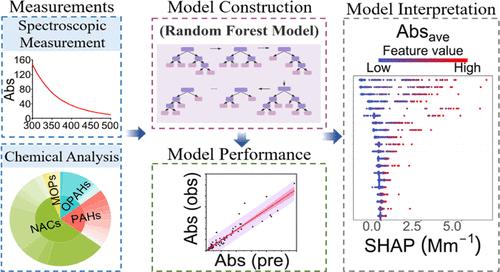当前位置:
X-MOL 学术
›
Environ. Sci. Technol.
›
论文详情
Our official English website, www.x-mol.net, welcomes your
feedback! (Note: you will need to create a separate account there.)
Predictions of the Optical Properties of Brown Carbon Aerosol by Machine Learning with Typical Chromophores
Environmental Science & Technology ( IF 10.8 ) Pub Date : 2024-11-07 , DOI: 10.1021/acs.est.4c09031 Ying Wang, Ru-Jin Huang, Haobin Zhong, Ting Wang, Lu Yang, Wei Yuan, Wei Xu, Zhisheng An
Environmental Science & Technology ( IF 10.8 ) Pub Date : 2024-11-07 , DOI: 10.1021/acs.est.4c09031 Ying Wang, Ru-Jin Huang, Haobin Zhong, Ting Wang, Lu Yang, Wei Yuan, Wei Xu, Zhisheng An

|
The linkages between BrC optical properties and chemical composition remain inadequately understood, with quantified chromophores explaining less than 25% of ambient aerosol light absorption. This study characterized 38 typical chromophores in aerosols collected in Xi’an, with light absorption contributions to BrC ranging from 1.6 ± 0.3 to 5.8 ± 2.6% at 365 nm. Based on these quantified chromophores, an interpretable machine learning model and the Shapley Additive Explanation (SHAP) method were employed to explore the relationships between BrC optical properties and chemical composition. The model attained high accuracy with Pearson correlation coefficients (r) exceeding 0.93 for the absorption coefficient (Absλ) and surpassing 0.57 for mass absorption efficiency (MAEλ) of BrC. It explains more than 80% of the variance in Abs and over 50% in MAE, significantly improving the understanding of BrC light absorption. Polycyclic aromatic hydrocarbons (PAHs) and oxygenated PAHs (OPAHs) with four and five rings exhibit significant positive effects on Absλ, suggesting that similar unidentified chromophores may also notably impact BrC optical characteristics. The model based on chromophore mass concentrations further simplifies studying BrC optical characteristics. This study advances understanding of the relationship between BrC composition and optical properties and guides the investigation of unrecognized chromophores.
中文翻译:

使用典型发色团的机器学习预测棕色碳气溶胶的光学性质
BrC 光学特性和化学成分之间的联系仍然不充分,量化的发色团只能解释不到 25% 的环境气溶胶光吸收。本研究表征了 习'an 中收集的气溶胶中的 38 个典型发色团,在 365 nm 处对 BrC 的光吸收贡献范围为 1.6 ± 0.3 至 5.8 至 5.8 ± 2.6%。基于这些量化的发色团,采用可解释的机器学习模型和 Shapley 加法解释 (SHAP) 方法来探索 BrC 光学性质与化学成分之间的关系。该模型获得了很高的准确性,BrC 的吸收系数 (Absλ) 的 Pearson 相关系数 (r) 超过 0.93,质量吸收效率 (MAEλ) 超过 0.57。它解释了 Abs 中超过 80% 的方差和超过 50% 的 MAE 方差,显著提高了对 BrC 光吸收的理解。具有 4 环和 5 环的多环芳烃 (PAH) 和含氧 PAH (OPAH) 对 Absλ 表现出显着的积极影响,表明类似的未识别发色团也可能显着影响 BrC 光学特性。基于发色团质量浓度的模型进一步简化了 BrC 光学特性的研究。这项研究促进了对 BrC 组成与光学特性之间关系的理解,并指导了对未识别发色团的研究。
更新日期:2024-11-08
中文翻译:

使用典型发色团的机器学习预测棕色碳气溶胶的光学性质
BrC 光学特性和化学成分之间的联系仍然不充分,量化的发色团只能解释不到 25% 的环境气溶胶光吸收。本研究表征了 习'an 中收集的气溶胶中的 38 个典型发色团,在 365 nm 处对 BrC 的光吸收贡献范围为 1.6 ± 0.3 至 5.8 至 5.8 ± 2.6%。基于这些量化的发色团,采用可解释的机器学习模型和 Shapley 加法解释 (SHAP) 方法来探索 BrC 光学性质与化学成分之间的关系。该模型获得了很高的准确性,BrC 的吸收系数 (Absλ) 的 Pearson 相关系数 (r) 超过 0.93,质量吸收效率 (MAEλ) 超过 0.57。它解释了 Abs 中超过 80% 的方差和超过 50% 的 MAE 方差,显著提高了对 BrC 光吸收的理解。具有 4 环和 5 环的多环芳烃 (PAH) 和含氧 PAH (OPAH) 对 Absλ 表现出显着的积极影响,表明类似的未识别发色团也可能显着影响 BrC 光学特性。基于发色团质量浓度的模型进一步简化了 BrC 光学特性的研究。这项研究促进了对 BrC 组成与光学特性之间关系的理解,并指导了对未识别发色团的研究。


















































 京公网安备 11010802027423号
京公网安备 11010802027423号